#its like.. a passive structure in active voice
Explore tagged Tumblr posts
Text
i know that the language you speak natively basically wires your brain to think in a certain way but its always been so hard for me to understand how other languages’ word orders make sense. im taking my second semester of latin and being in this class & the last is the most ive ever had to think about it bc i only took very basic spanish in 4th grade. at least latin is pretty flexible but the typical sentence structure is still weird!
like in my mind a subject-verb-object order is.. it feels temporal. it feels like it describes a sequence of events chronologically, although thats not really true. the most important parts of the sentence come first! i dont have to wait until the end of the sentence to know what is being spoken about & what it did. the verb is almost always at the end of its clause and sometimes the subject is included in it AND the subject is defined by the END of the verb, eg “eam gessit” means “he/she/it carried her” but reads in order something like “her carried(he/she/it).” its not that bad in short sentences, but with a bunch of phrases ? i would hate having to listen to someone speaking it/conversationally bc wtf get all that shit out of the way n get to the POINT what are we TALKING about
#its like.. a passive structure in active voice#its still very fun to learn about! its a brainteaser trying to work out some sentences#one thing that i will admit is basically more logical in otber languages is adjectives following instead of preceding their nouns#like ‘the black cat’ makes more sense to me bc thats what i Know but why would we say the description before what we are talkimg about?#‘el gato negro’ is just Actually better even if it feels awkward#birdsong
0 notes
Note
do you have any tips on pacing? for me I always tend to right way faster then I would like to. thanks!
Writing Notes: Narrative Pacing
The best storytellers across all genres of fiction writing are often masters of the pace at which the story unfolds.
Pacing - refers to how fast or slow the story is moving for the reader.
This is determined by the length of a scene and the speed at which you, the writer, distribute information.
Generally speaking, descriptive passages tend to slow things down, while dialogue and action scenes speed things up—but slowing the pacing of action down at choice moments can also build suspense.
Good pacing is crucial to the flow of a successful narrative and without it, the story is dead on the page.
The reader wants to be immersed in the thoughts and actions of your characters.
They want to feel that they’re in the world you’ve created.
Clunky language, bad dialogue, and poorly-conceived scenes will all draw your reader out of the story.
Pace will help keep them there.
Writing Tips: On Narrative Pacing
Whether it’s through subplots, playing with sentence structure (longer sentences can slow things down, rapid-fire dialogue and short sentences can speed them up), or experimenting with passive versus active voice—here are a few ideas to keep your story moving:
Utilize breathers. By balancing action scenes with more reflective, internal moments, you give the reader an equal dose of excitement and recovery. The quieter moments in any novel—the “negative space”—are the places to share relationship details, a character’s thoughts and memories, and anything a character might do while taking a break. These spaces, which are just as important as the more dramatic scenes, give readers a chance to orient themselves and process their reactions. Too much of the same pace—no matter how exciting it is—will begin to feel tedious to the reader.
Change the order of events. Try a method called in medias res—opening the story in the middle of the action and filling in details later. This works well when you want to capture your reader’s attention quickly, like in a short story. If you are writing something longer, try placing the sole dramatic question of your story upfront while using the rest of the novel to slowly parse out information that leads to the final answer. Your readers will keep reading to discover the answer to the question you’ve given them.
Vary your sentence length. Try breaking up long passages of exposition with short dialogue—even a sentence or two can be refreshing. If you have a very long section of dialogue, insert brief sections of exposition to keep your reader grounded in time and place.
Keep characters physically moving during dialogue. If your characters are on the run and having a conversation in an airport, you can show the numerous distractions they might notice as they walk nervously through the airport. By interspersing brief distractions (clumsy passengers, stern security guards) between segments of dialogue, you prevent the pacing from becoming monotonous.
Reveal information selectively. Writing suspense into any novel is a matter of controlling information—how much you reveal, and when and how you reveal it. In its most practical sense, suspense is a series of incremental steps. While every novel will have a central, overarching storyline that seeks to answer the sole dramatic question, that question is an engine built of thousands of smaller components that carry the reader through each chapter, sustaining their interest along the way.
Vary your narration. In all writing, there are 2 types of narration: scene and dramatic narration. In the former, you show the characters performing an action or having a conversation. This tends to speed up the pacing. In the latter, you simply tell the reader what the characters did, but the event remains “offstage.” This type of narration can slow the story down. To keep pacing from feeling monotonous, it’s a good idea to vary the two modes of writing. Show the reader a scene when it’s interesting or necessary, and use a summary to move over the less exciting parts.
Read the work out loud. Notice the amount of time it takes you to read through a scene and pay attention to how the sentences feel to read and mark where the rhythms naturally change. Where should you slow down? Where should you pause? Where should your pacing gain momentum?
How to Pace Your Novel
How Long Should Book Chapters Be? The overall story arc of a novel is essential, but meticulous construction of individual chapters is just as important to the reader’s experience. Here are a few of David Baldacci's tips for structuring chapters:
Keep scenes and chapters short. David keeps his chapters short—between three to five pages. This keeps the narrative moving at a brisk pace.
Keep your audience asking questions. When a chapter answers a question from a previous chapter, you have the opportunity to introduce a new one. The new question will propel you through the next chapter. A classic example from crime fiction: “Will this serial killer strike again?” becomes “He struck again—now how many more people will he kill?” Keep this up over the course of a novel, and the book will be a page-turner.
Make sure each chapter has a purpose that ties into the bigger story. If you lose sight of the overarching narrative of your novel, your individual chapters can begin to feel aimless. To keep your novel focused and on track, you should have a clear objective with every scene you write.
Don’t fluff up the novel with irrelevant content. Scene-setting and vivid descriptions are critical for a compelling novel, but don’t get bogged down in the details. Focus on sustaining narrative momentum from chapter one onward.
Make your scenes multitask. Driving the plot forward, conveying information, and deepening a character’s development are the three most critical jobs that a chapter can do. The short chapters you write should make use of at least one of these tools, and preferably more than one.
A Writing Exercise on Pacing
One person punches another.
Describe this act in 10 words.
Describe the same act in 100 words.
You’ll find that the second description reads more like the end of a chapter, while the first may sound more like the beginning or middle.
To follow up, write a scene leading up to the punch and play with sentence lengths.
For the scene leading up to 2, for instance, try making all the preceding sentences no longer than five words apiece.
In the scene leading up to 1, keep all the sentences equally short, except when you get to the action that directly provokes the punch and describe that one action in 100 words.
After completing this exercise, you should see how very different the exact same scene can feel, depending on which elements of that scene are sped through, and which are dragged out.
A good advice on pacing: Read and learn. The next time you come across a book that keeps you up all night turning pages, give it a second read once you’ve finished and caught your breath. Take a look at what the author does, whether it’s speeding up scenes, slowing them down or shifting points of view at crucial moments. Odds are, you’ll appreciate the book even more… and pick up a few pacing tricks of your own.
Techniques to Slow Down the Pace
Lengthen your sentences
Add descriptions
Include subplots
Use flashbacks and backstory
Add more introspection
Techniques to Speed Things Up
Shorten your sentences
Use more dialogue
Remove (or limit) secondary subplots
Use cliffhangers
Increase the action
There is no formula for a great story: it can be either fast or slow depending on how it is told. So, don’t be afraid to play with your story’s pacing and explore different ways in which a scene can be slowed down or sped up until you find the right fit. Above all, remember that nailing the pace is a matter of balance.
Sources: 1 2 3 4 ⚜ More: Writing Notes & References
Hope this helps with your writing!
#anonymous#on writing#pacing#writing tips#writeblr#writing advice#literature#writers on tumblr#dark academia#writing reference#spilled ink#writing prompt#creative writing#light academia#fiction#novel#writing resources
192 notes
·
View notes
Text
things that help me write in case anybody else hasnt found their process and wants a little inspiration:
clean room = clean mind = brain empty = BAD = writers block. have the perfect amount of messy in your room, but an organized writing space. for me, i associate a clean room with a clear mind. empty room, empty mind. if i have a clear mind, im probably thinking thoughts my therapist would be proud of, im also probably thinking about wellness and cleanliness and happy things and spiritual wellness and hmmm maybe i should do yoga. well guess what? writing is messy. writing is having bad thoughts, bad ideas. writing is thinking "how can i hurt my character the most?" or "how can i comfort my character after being hurt?". in order to figure that out you have to let it be chaotic. but EVERYTHING has a spot, okay? for me, i have a pile dedicated to clothes, all tossed into a reusable bag, with a few shirts artfully spilling out onto the floor. but other than that, my floor is relatively clean. you want chaotic, not crowded.
have a spot dedicated to writing. im not talking "this is the only place im allowed to write", im talking a writing shrine. all of my writing stuff is on my nightstand, this way i can write in bed or on the floor, whichever i deem my designated writing space for the day. my notebooks in the same spot. my bluetooth keyboard is also there. i have a cup for pens and highlighters. i have pages ripped out of notebooks filled with tips for revising. passive vs active voice. varying sentence structure. i have an old notebook i used for my creative writing class that i can go to for finding poetic devices. i have a blank sketchpad that ive been using to make little charts or timelines. the books i need for reference are all in my little spot. also thats where my snacks go (offerings to the gods, aka the evil tarantula in my brain making webs of LIES ((bad, bad headcanons)))
have a special writing thing. basically the equivalent of lucky socks or lucky charms or literally whatever, except its for writing. i have a shirt i specifically wear when i plan on writing. its literally just a cream white button up. i dont NEED to wear it in order to write, but on days where i know i can write but am still struggling, putting it on really helps. i struggle to write in special outfits because most of the time, if im wearing a cute outfit, i am performing. well writing isnt a performance. i am a scatterbrained rat. so its usually pajama bottoms and my writing shirt. booya.
water. idfc. idfc. water. water. drink it. chug an entire 20 oz in one go unless you think youll get sick. if youre not gonna get sick, get to chugging. "i always forget" cool me too. adhd sucks man. but i have POTS, so i have to drink 120 oz of water a day. the thing is, i NEVER remember its there. everyones always taking sips at a time and then forgetting they even own a water bottle. solution? drink the entire thing in one go. do it coward. its the only way. if drinking water gives you a stomach ache, i promise you, thats because youre dehydrated. you will get used to it. im sorry it hurts. but the more water you drink, the more it starts to go away. the headaches stop. suddenly you actually start to crave food, and it doesnt even hurt to eat it?????? what???? yeah man. water helps pretty much everything. i might make a separate post to talk about this actually.
find your medium. paper? keyboard? you do both, but for different things? for me, i like to write in notebooks. idk, it just works. i discovered this in my creative writing class. she had us use notebooks and i discovered that writing by hand really gets me in the flow. writing with a keyboard makes me want it to be perfect, and overall, i really struggle to read things on a computer. however, i do like using keyboards because the words get typed faster. problem is, when im using a keyboard on a hard day, my brain cannot keep up with my fingers, and so i stop typing to think of a word, and then im out of the flow. writing it by hand takes longer and gives me ample time to come up with sentences. also the cursor isnt blinking at me menacingly. but also, if ur a paper person, ONLY EVER WRITE IN PEN!!!! ITS LITERALLY A GODSEND!!!!!
some days, you just need to write different things. what i mean by this is there are days when i can absorb information and give instructions, and then there are days when i can follow the instructions. i say "im going to take notes on how to use passive vs active voice", and thats what i wrote for the day. other days, i look back at my notes and i say, "yes im going to put this into practice", and then i DO. writing is writing man. learn as you go. no matter what, youre writing. some days its a notes day. some days its a letter to your best friend. some days its a poem. some days you actually sit down and write the fucking shit you wanted to write (finally). also remember that you dont need to write the same amount of words every time, too. i wrote 18 pages by hand all in one day. the next day? i barely wrote 3. the day after that, i didnt write at all. THAT IS PERFECTLY ACCEPTABLE.
find your system. no im not talking about this writing routine im informing you of right now, im talking do you plot or do you have vibes? are you a very weird, confusing, and inconvenient mix of both? lol. me too. you CAN plot. you CAN just have vibes. but which one actually gets you to start writing? figure out which one you are. think on it rq, cuz it leads to the next one.
timelines can suck it. for me, if i figure out a consecutive timeline, my motivation goes out the fucking door. this is because i FUCKING HATE HATE HATE HATE time crunches. EVEN THOUGH IT'S NOT MY TIME CRUNCH????? ITS THE CHARACTERS?????? basically, for the first draft, i cannot have any concept of time in my story, otherwise i will feel trapped, like i HAVE to do it in the way i originally planned, and then I'll never write it. so how i solve this, is i get an idea. just one. one idea, for one scene. i write that idea down as a little summary (and i really mean little, guys) and add a couple notes to give it vague vibes (moonlight shining through branches, water droplets on skin, laughter, etc), and THEN i write that scene down from memory. this is because i primarily write based on vibes, even though in my head i know exactly how this scene is going to serve the plot, and where exactly this bad boy will fit in my plot. but i know i might change my mind later, so i dont write that down. i recommend doing this if you have adhd, because if youre only writing down ideas one right after the other, chances are, you are not elaborating on them enough for your future self to go back and fall in love with the little note you made. we are just too forgetful. so you write down one idea, add little notes on the vibes you want to incorporate in your idea, and then you go and write the scene. thats it. one at a time. if you come up with another idea as you go, write it at the top of the page where the title goes and pray to god it sticks in your brain when you find it again.
i hope this helps a little in a very adhd way? this is my process (its not really process, more like a rulebook). i hope it inspires you guys to find the things that work for you, or at least opens your mind to the more chaotic organization your brain might need. i know i really struggled with the advice that suggested i do things neurotypically???? like no thanks. nuh uh.
#writer#ao3#ao3 writer#writeblr#writing life#writing is hard#writer things#writing community#writing advice#writing#writer struggles#adhd#adhd writer
41 notes
·
View notes
Note
It matters a lot that Spain is being vocal when the rest of Europe sits and claps at whatever the US and Israel say, is enough visibility when you have people like Meloni diminishing the US’s hand in the current global instability (like always). She shamelessly says that blaming the US is a simplification and here, many leftists voted her, many leftists believe that our overtly fascist government is merely an offset because fascism is dead. So to me, it’s a huge deal to see Spanish government officials rising their voice, it’s the bare minimum sure but is better than what the rest of the world is doing.
Look, I’m very critical of Spain in many political and social aspects. I’ve always thought—and I still think—that Spain isn’t really a progressive country, no matter how much it tries to sell itself that way abroad. It’s a country with a very strong fascist legacy, deeply rooted in several generations because of the dictatorship, repression, fear, and the ideological apparatus that was ingrained in us for decades. That doesn’t just disappear overnight and it’s still there, shaping how we think, how we vote, how we react collectively. That residue is noticeable.
But it’s also true that when I started traveling I realized something: that push after the dictatorship ended, that collective urge to recover lost time, to catch up at full speed, ironically placed us at the forefront on many issues. It’s a strange mix, because we still have deeply conservative structures —from the judiciary to the media— but at the same time there’s a very alive social awareness and a historical memory that, although barely, keeps pushing forward. So when you see other European countries, which have always been sold to us as examples of progress and democratic sophistication… sometimes you realize they’re full of prejudice, stale discourses, and hypocrisy that’s embarrassing.
In that context, yes, I think it’s important that the Spanish government is raising its voice. Is it the bare minimum? Absolutely. Should it be normal? Also. But the fact that it stands out, that it makes headlines, and that outside our borders we’re looked at as if we’re doing something brave just by stating the obvious is tragic. Because what it highlights is how deeply the international community is sunk in cowardice, in following the lead of Washington and Tel Aviv, and in a political cynicism that’s disgusting.
And then there’s the issue of islamophobic discourse, which makes me sick. Because we’re not just talking about passivity in the face of genocide, but active complicity based on deeply racist prejudices. It’s pure racism. Institutional islamophobia, colonialism recycled for the 21st century. And again Europe applauding. I don’t know what’s worse, the silence or how they justify the unjustifiable.
Then you see all that European far-right with their “Europe for Europeans,” “down with Brussels bureaucracy,” “we’re sovereign,” speeches, and then they run to suck up to Trump or act as obedient pawns of NATO. It’s ridiculous. They’re servile. All these people who pose as anti-establishment but have zero criticism for the real power controlling the world stage.
I don’t have national pride. Never have. Spain has embarrassed me countless times and still does in many ways. But this government stance—although insufficient—makes me feel represented, at least in the essentials. I That said, I’d really be proud if diplomatic relations with Israel were cut, if the embassy was closed, if serious economic sanctions were applied, if all trade with them stopped and if the economic support of this genocidal structure was ended with agreements and empty words. But well, dreaming is free lol
#spain#spanish goverment#spanish politics#israel#israhell#israel is a terrorist state#israel is committing genocide#israel is an apartheid state#israel is an illegal occupier#antizionism#anti zionisim#ethnic cleansing#gaza genocide#palestinian genocide#free gaza#free palestine#i stand with palestine#save palestine#politics#international politics#OTAN#NATO#europe#european union#FASCISTA MUERTO ABONO PA MI HUERTO HIJOS DE PUTAAAAAAA
21 notes
·
View notes
Text
Wei Wuxian and Narrative Agency – Part Three
For Xiantober Day Five: Past and Present, in which the author gets very unhinged about what parts of the past are shown and how that’s affected by the present!
(Part One | Part Two | Full version on AO3)
The Power of Agency: Shaping the Narrative
When I've discussed Wei Wuxian's agency previously, I’ve talked about how what’s shown and omitted tells us about a character, and we’ve talked about the character himself. Though this is a niche topic, it’s not necessarily something out of the ordinary to analyse, and we can assume everything up to here has been in some way intentional.
This? Linking structure to a character’s in-universe preferences?
This is where we get unhinged.
Before I start, let’s quickly establish something which will be important later: although Wei Wuxian is the central character, MDZS isn’t strictly from his POV. While omitting events a character doesn’t like to dwell on and concealing things the character wishes to hide is common in books with only one narrator, MDZS has multiple narrators which it switches between relatively quickly. This includes Wei Wuxian, but it also includes nearly every major character that appears in the story, and omniscient narrator as well. As a default, this format doesn’t lead to this deliberate shaping and omission because of one character’s preferences, since we have many other sources of information and events – which is what makes Wei Wuxian’s influence over the narrative and structure so interesting. We could have access to a lot more information, and access to it at different times, than we do (and that’s not an insult, quite the opposite!).
To begin: we’ve established that times such as Wei Wuxian’s time on the streets, his three months in the Burial Mounds and his loss in the Siege aren’t shown because Wei Wuxian has little agency there. But that’s not the only special thing about them. They’re also the three most traumatic times in his life, and so moments Wei Wuxian himself either can’t remember, or doesn’t like to dwell on.
This is why discussing Wei Wuxian’s treatment of tragedy in his life was important. Firstly, it shows he doesn’t focus on the tragedy in his life, so the idea that the narrative not focusing on this tragedy relates to his character has merit; secondly, it affirms that this is not a passive trait, but a choice. Therefore, when the narrative omits events due to this aspect of Wei Wuxian, it’s respecting not only a character detail – which would be cool by itself – but also an active decision. One that shapes the story it’s made in.
In other words, its very structure is respecting Wei Wuxian’s agency!
Now, of course there are flashbacks to other moments of his past he probably wouldn’t like to dwell on, too. But within the structure, they’re only shown when Wei Wuxian is thinking about them (or when he has reason to)!
Wei WuXian hadn’t woken up yet. His eyes were still tightly shut, yet his hand didn’t let go either. He seemed to be dreaming, muttering, “… Don’t… Don’t be angry…” Lan WangJi seemed somewhat surprised. His voice was gentle, “I am not angry.” Wei WuXian, “… Oh.” Hearing this, as though he finally felt assured, his fingers loosened. Lan WangJi sat beside Wei WuXian for a while. Seeing that he was motionless again, he was about to stand up when Wei WuXian grabbed him with his other hand, hugging his arm and refusing to let go. He shouted, “I’ll go with you, quick, take me back to your sect!” Chapter 63, EXR translation
Which, of course, is him dwelling on…
Lan WangJi spoke one word at a time, “Go back to Gusu with me.” Hearing this, both Wei WuXian and Jiang Cheng were surprised. Quickly afterward, Wei WuXian laughed, “Go back to Gusu with you? To the Cloud Recesses? Why go there?” He immediately seemed to realize, “Oh. I forgot. Your uncle Lan QiRen hates crooked people like me. You’re his proudest disciple, so of course you’re the same as him, haha. I refuse.” Chapter 62, EXR translation
…the painful flashback immediately preceding this. The third set of flashbacks (which are also painful) are a similar case. Look at the contex:
He lifted the bottom of his robe, revealing a prosthetic leg made of wood, “This leg of mine was destroyed by you, that night in the Nightless City (…)” (…) “Wei WuXian, I won’t ask you if you remember or not. Both of my parents died by your hands. You owe too many people. You definitely won’t remember them either. But, I, Fang MengChen, will never forget! And never forgive you!” (…) “In the fight at Qiongqi Path, my son was strangled to death by your dog Wen Ning!” “My shixiong died by poison, his entire body festering due to your cruel curse!” Chapter 68 (immediately preceding the flashbacks), EXR translation
And Wei Wuxian’s own thoughts and words:
Wei WuXian looked at the cultivators before the Demon-Slaughtering Cave. Their expressions were the absolute same as those of the cultivators from the night of the pledge conference, pouring their wine on the ground as they took the pledge to scatter the ashes of the Wen Sect’s remnants and him. (…) Wei WuXian, “Now it’s time to ask just whom it is that treasures it so much. It’s like Wen Ning. Back then, some certain sects or so were scared to death of the Ghost General. They said they’d kill him on the surface, but behind their backs they hid him for over ten years. How strange. Who was the one that said his ashes had been scattered back then?” Chapter 79 (immediately succeeding the flashbacks), EXR translation
Once again, Wei Wuxian’s own thoughts relate to the flashbacks we’ve just been shown. And, as I previously mentioned, though all the events which are shown are tragic, they’re also events which Wei Wuxian’s own choices and actions shaped – which he has this to say about:
“The things I did, not only do you remember them, I remember them too. You won’t forget them, and they’ll stay even longer in my mind!” Chapter 82, EXR
Admittedly, this applies more to the third set of flashbacks than the second (which is still fitting as the third set was the most recent), as in the second, although he still had agency within and influence over his circumstances, the majority of the pain was caused by others’ actions (excluding, of course, the Golden Core transfer… which is something we know stays for a long time in his mind, albeit with a caveat we’ll soon discuss). But it’s still important to note – especially considering that otherwise, focusing on this very painful time in his life wouldn’t seem like something very in-character for Wei Wuxian to do.
Of course, this can all just be explained by good writing. It is best to insert flashbacks when they’re relevant to the characters and events in the present day! But it is interesting to compare these to the start of the (not painful) Gusu flashbacks, which open this way:
At a later time, Wei WuXian pondered upon the reason why his relationship with Lan WangJi wasn’t good. Getting to the root of the matter, everything started when he was fifteen, coming to the GusuLan Sect with Jiang Cheng to study for three months. Chapter 13, EXR
Again, considering the circumstances around which these flashbacks take place – returning to the Cloud Recesses for the first time since the lectures, and meeting Lan Wangji once more – it makes complete sense for Wei Wuxian to be thinking about these events*. So it does fit the pattern of Wei Wuxian dwelling on something, thus leading to the narrative dwelling on it, too (and being shaped by his thoughts)… but there’s another layer to this. Importantly, it is the only flashback where Wei Wuxian’s present thoughts don’t lead to this happening, with his thoughts at an unspecified future time leading to it, instead. I like to interpret this as the text saying that, since these events aren’t something Wei Wuxian wouldn’t focus on in normal circumstances, he can dwell on them at any time. Therefore, they’re free to come up in the narrative at any time as well, even if he’s not dwelling on them in the present moment!
So, to summarise: Wei Wuxian’s decision not to focus on the painful times in his life directly influences the narrative to not focus on these times. When painful times are brought up and shown to us, it’s in the context of him thinking about them in the present day, and even then, his most painful moments still aren’t shown to us. His agency in this regard is still respected by the narrative structure.
This is the main way his agency influences the structure of the narrative, but I’d like to talk about the revealing and concealing of information, too. For example, I said I’d talk about the Golden Core transfer – though Wei Wuxian does think about this many times, as evidenced by his internal narration in Chapter 103. But unlike everything we’re shown through the flashbacks, this is something Wei Wuxian is actively trying to hide from others. And the narrative respects this choice (Wei Wuxian’s agency, again), never reveals it even when it would be relevant in the flashbacks, and we find out not through narration, but through a character’s dialogue!
And to clarify – I know these aspects may not be in the book for this exact reason. Showing flashbacks in relevant moments is good writing, concealing an important plot point you want to do a reveal for is necessary writing, and MXTX has said she didn’t want to write about Wei Wuxian’s time in the Burial Mounds, due to not liking to write transformation sequences (and also because it would not be pleasant at all, which likely also applies to Wei Wuxian’s death). That doesn’t prevent it from also being intentional – MXTX’s intelligence is shown in many aspects of this book, and there’s nothing disproving it – but there’s no proof for either option, so I won’t pretend there is. I bring this up because I know this feels like I’m overanalysing, as I feel that way as well.
But, whether it’s intentional or not, it exists in the text, and I adore it – so, regardless, it’s something I’ll explore. Because taking this into account… We aren't just told about Wei Wuxian having agency, we aren’t just shown it in the text, we aren’t even just shown it through which parts of his past are shown and hidden in the structure of the text (as I talked about in Part One). The parts of the past that are shown and hidden also have an in-universe reason for being shown and hidden, this reason being the choices he makes! Agency is the ability of a character to influence the story they’re in, but Wei Wuxian’s agency, as a property of a character who only exists in-universe, shapes the out-of-universe structure as well! That’s how we’re shown its importance! How cool is that?
At The End Of The Road: Summary and Final Thoughts
In this essay, we’ve covered how important Wei Wuxian’s agency is not only to the events of the plot, but to the structure of the narrative as well. The narrative omits periods in which Wei Wuxian has little or no agency, in favour of showing us periods in which he does, even when important events happened in the former. This indicates that who Wei Wuxian is without agency isn’t important enough to be shown to the audience, and therefore that his agency is an integral aspect of his character in MDZS. We’ve discussed how both in-universe and out-of-universe, tragedy does not define him – out-of-universe, the tragic events in Wei Wuxian’s life are used not to build sympathy but rather to show his strength of character and who he still is despite going through them; and in-universe, he chooses not to focus on the negativity and resentment caused by his circumstances or others’ actions, instead staying true to his moral compass and enjoying his life in the present day. Finally, we’ve also explored how this choice is another reason for the omission of certain events from the narrative, resulting in his agency shaping the story in a very literal way – it affects the out-of-universe structure, as well.
It’s quite fitting, for a story whose essence is about defying a conventional narrative – that of righteous clans rising up and defeating a great evil – and about a character who defies many conventional narratives on his own – that of status defining how skilled you could be, that for a golden core being necessary for cultivation and other paths being unavailable, that of a tragic but complete story of someone killed for staying true to their moral code (instead, that character returns to life and has a happy ending) – to have its own narrative play a role in such an important and interesting way.
(Or, if an image would be preferable:)

Thank you for reading!
(Part One | Part Two | Full version on AO3)
--
*This strong relation to the present day circumstances is another reason I love the flashback placement so much (and why I think it’s such a loss both screen adaptions altered it so strongly)!
#get ready for tag thoughts because there are a LOT of them#it’s for THIS reason that fanon wwx bothers me so much (didn’t want to get negative on the acual post)#bc so often all the changes are changes that woobify him!#self-sacrificial idiot wwx?? only doing things because… poor him he has so many internal issues and values himself so little-#-so of course he’d sacrifice everything before thinking of another option? woobifying#(whenever he sacrifices something it’s a deliberate choice to act on his morals because he values his morals so much – and he’s also very-#-capable and DOES often find ways for no people to get hurt!)#wasn’t aware that what happened to him at lotus pier was wrong and needs lwj to tell him that for him to have any idea if it?#woobifying (as we see in the lotus seed pod extra he KNOWS it’s unfair)#(he downplays it retroactively in his memory (links into not focusing on the bad things in his life))#(but that’s the actions themselves that are being downplayed not their fairness!)#he chooses to act! he is defined by acting! not tragedy – all the more impressive in the face of the amount of tragedy that’s happened#he could SO EASILY have been a woobie but instead he’s the opposite of one: defined BY his agency instead of the absence of it#that doesn’t mean he’s not impacted by tragedy or trauma – he is! but it’s not the most important aspect of his character (bc he doesn’t le#it’s also something that bothers me about the changes cql made#by making qq path and nightless city the fault of someone else it means he IS someone who’s more a victim of circumstance than anything els#he had no control over the tragedies of his first life at all#apart from ig his death being controlled by him? because he just leaps off the cliff during the nightless city siege?? but in THAT case it’#i watched that part recently (i’m getting through it very slowly) and yeah it reaffirmed my love for this aspect of the book even more#despite. having these exact thoughts for two years already#he also dwells on the past events a lot more than book wwx which adds to that version of him BEING defined more by tragedy rather than who#anyway over 7.3k words total (and 400 more in the tags apparently)... it'll be posted to ao3 in its completion this evening!#mdzs meta#my meta#wei wuxian#mdzs#mo dao zu shi#魔道祖师#grandmaster of demonic cultivation#gdc
65 notes
·
View notes
Text
Dandy's World OC: Romeo Valentine (💘)
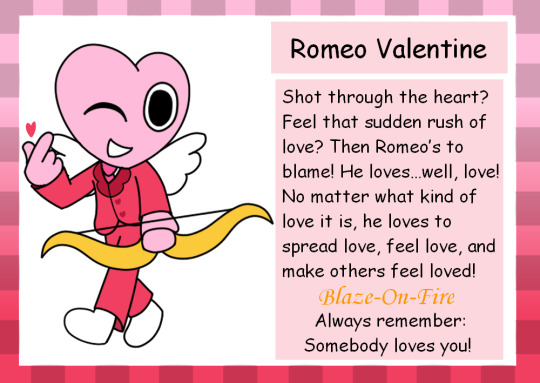
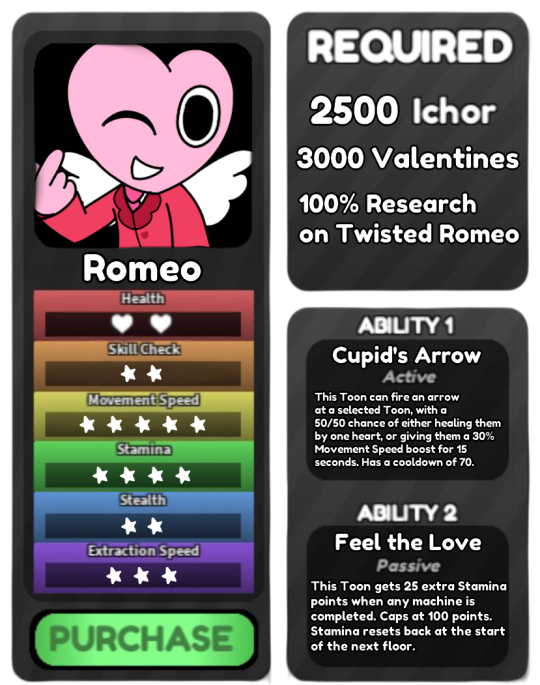
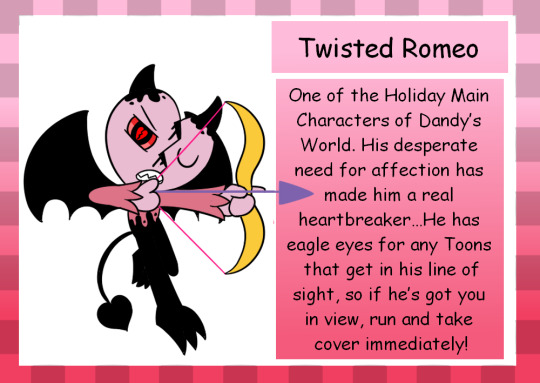
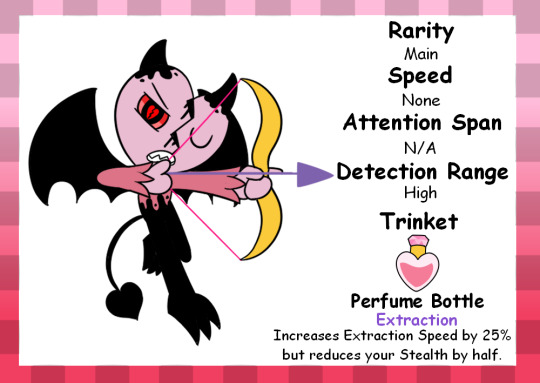
No Valentine's Toon? Fine. I'll do it myself.
Bio and details below!
“Shot through the heart? Feel that sudden rush of love? Then Romeo’s to blame! He loves…well, love! No matter what kind of love it is, he loves to spread love, feel love, and make others feel loved!
Always remember; somebody loves you!”
Full Name: Romeo Valentine
Species: Heart
Gender: Trans Male (He/Him)
Voice Claim: Miles McKenna
Romeo Store Quote
“Me? Excellent choice! I promise I’ll make it worth every valentine~”
Requirements
3000 Valentines
2500 Ichor
100% Research on Twisted Romeo
Appearance
Romeo is a pink heart sporting a pair of white wings. His outfit consists of a pinkish red tuxedo with dark red lapels resembling a heart, a white undershirt with a rose pink tie with its knot resembling a heart, dark red heart buttons, pinkish red pants, and white shoes.
In his info card and posters, he’s often seen wielding a golden bow and pink arrows with red hearts at the ends of them.
Personality
As one can probably tell, Romeo loves…love! He loves spreading love, feeling loved, and making others feel loved. He has a rather playful and flirtatious personality, both towards other Toons and even the player. He likes to play matchmaker and generally help Toons with their relationships, even if it can come across as pushy and invasive at times. Aside from all that, he is generally optimistic and positive, believing fully in the power of love of all kinds.
However, underneath all the sweet glitz and romantic glamour lies an insatiable hunger for affection. As such, he is very sensitive to rejection and abandonment and will seek affection by any means necessary. Romeo does also have a bit of a cheeky side to him, as seen in his interaction with Shrimpo.
Stats
Rank: Main Health: ♥️♥️ Skill Check: ⭐⭐ (Size 100 / Value 1.5) Movement Speed: ⭐⭐⭐⭐⭐ (Walk 20 / Sprint 30) Stamina: ⭐⭐⭐⭐ (175) Stealth: ⭐⭐ (5) Extraction Speed: ⭐⭐⭐ (1.00)
Abilities
Cupid’s Arrow Active This Toon can fire an arrow at a selected Toon, with a 50/50 chance of either healing them by one heart, or giving them a 30% Movement Speed boost for 15 seconds. Has a cooldown of 70.
Feel the Love Passive This Toon gets 25 extra Stamina points when any machine is completed. Caps at 100 points. Stamina resets back at the start of the next floor.
Dialogue
Finishing extraction
“Lovely!” “That sure got the heart pumping!” “Have a happy Valentine’s Day!”
Descending to the next floor
“Ah~ Can you feel the love tonight?” “Oh ho~ Looks like love is in the air!” “Maybe I should stop wearing so much perfume…”
Activating Cupid’s Arrow
“This arrow’s just for you!” “You are loved; don’t you forget that!” “Shot through the heart, and I’m to blame~”
Twisted Romeo
"One of the Holiday Main Characters of Dandy’s World. His desperate need for affection has made him a real heartbreaker…He has eagle eyes for any Toons that get in his line of sight, so if he’s got you in view, run and take cover immediately!”
Rank: Main Speed: N/A Attention Span: N/A Detection Range: High
Twisted Romeo is a stationary Twisted that, similar to Twisted Annie, will stand in the middle of a floor. He basically acts like a sniper, when a Toon ends up in his detection range, he will point an arrow at them. This is displayed by a line of ichor that goes from him to the Toon he’s targeting.
A number will display above the targeted Toon, counting down from 3 to 0. If the Toon is still in his line of fire after the countdown reaches 0, Romeo will shoot an arrow at them, dealing one heart of damage if it hits. If the Toon hides behind a wall or structure or manages to get far enough away from him, he will cease fire or move on to the closest Toon in his sight if there is one.
The arrow can also be dodged after it’s shot if you’re quick enough. He can also be affected by abilities that blind Twisteds.
While he doesn’t move, he makes the sound of a beating heart, which gets louder and faster the closer you are to him.
Twisted Research Trinket: Perfume Bottle Trinket Category: Extraction Increases Extraction Speed by 25% but reduces your Stealth by half.
Trivia
Romeo’s first name comes from the eponymous character of Shakespeare’s play “Romeo and Juliet”
In the lore, Romeo is a trans man because he was originally conceptualized as a female named “Juliet” and was referred to as such a few times during the concept phase, but was then changed to a male.
Despite his flirtatious personality and desire for love and affection, Romeo is actually aroace. Making the love he desires to be platonic.
While she’s not playable, Romeo does have a pet lovebird named “Juliet”, after his initial name from the concept phase.
One of his elevator quotes is a reference to the song “Can You Feel the Love Tonight?” from The Lion King.
His info card, and one of his ability quotes reference the song “You Give Love a Bad Name” by Bon Jovi.
Much like how Bobette is Dandy’s World’s equivalent to Santa, Romeo is Dandy’s World’s equivalent to Cupid.
#dandy's world#dandys world#dandys world oc#dandys world ocs#dandy's world oc#dandys world fanart#dandy's world fanart#dw fanart#dw oc#romeo valentine
23 notes
·
View notes
Text
//Narrative communication established.
//[ASSIST: CONDENSE]> RESPONSE BELOW READMORE
--READMORE BYPASSED--
Thermie’s time with the Attica City Jäger Guard is brief yet enlightening.
Every ounce of energy is different from the Academy. Sure, there are mechs and Pilots being ferried about the hangars, but walking-paces time differently. Officials treat their pilots with something akin to respect (with stretched-definition). The air feels both lighter and heavier in various ways- social-tension, gravity-presence, the absent hum of atmosphere recycle-systems.
After the defeat of MTK-VOKOLOSS (“MECHANIZED-TYPE KAIJU,” an unofficial designation xey find appealing), xey spend the rest of xeir stay almost exclusively docked within the Guard’s hangars. None of the subalterns xey try on for size feel right- either with the wrong number of limbs, or improperly-structured legs, or a balance issue, or (in a particular case) a dent on the upper torso that sends xeir weight-adjust calculations all screwy.
Thermie doesn’t mention to the Guardsmen’s team that xey have a mech-bay waiting back “home” at the Academy. Oracle would thank xem for the free repairs and congratulate xem for not looking a gift in the mouth… according to baseless predictions. Somewhere in that simulation, a single clip of honor tries to bloom before being decapitated.
Passive curiosity fares better in its soil-emergence. It starts as a seed: [Hurricane-Hunter]’s bright red Kidd in the furthest hangar bay, swarming with drones like an agitated hornet’s nest. Then, a sprout breaks the dirt: a drone wanders far from the frame, and is recalled back with a buzz of static that only xey and the drone seem to hear.
Thermie mimics a tongue-click to get the attention of a mechanic on xeir shoulder. The small, spindly human looks up from its snooping, quickly wiping its hand on its pant-leg when it comes away blood-slick from the side of xeir Smartgun.
//[QUERY: OPERATION]> How do commander-type frames similar to [Hurricane-Hunter] communicate with their drone swarms? I have noticed anomalous signals between its components, but they are unfamiliar to me.
The human cocks its head and makes a puzzled noise, as if it doesn’t understand Thermie’s question at first. It takes a second to think- process interruption blowback?- before finding the words.
“Not sure how that Kidd does it, but I know a lot of ‘em use Legionspace. Why?”
//[ELABORATE: DEFINITION]> “Legionspace”
“Uh-“ it lags again- “dedicated e-warfare system. Second reality that only tuned machines can play with. Also works for esoteric hacking shit.”
//Your explanation is appreciated. You may resume your own inquiries.
After a moment, the mechanic shrugs and goes back to poking at the flesh at the base of the Smartgun. Thermie rolls xeir optic case.
//Inconsequential.
[Hurricane-Hunter] fires another command to a wayward drone. The sound of it- is it even a sound?- seals the deal in Thermie’s mind; Soul-searching time. Xey disconnect xeir visual feed and turn xeir words inwards, diving through programs xey’ve never had the courage to boot.
//[DIRECTORY: NAVIGATE]> “ELECTRONIC WARFARE SYSTEMS” //[CALIBRATION: WARNING]> This module has not been serviced in [ERROR: NULL VALUE] cycles. Initialize? Y/N //[QUERY: INITIALIZE]> Y //[INITIALIZATION: MODULE]> Electronic warfare systems online. Redirecting system cognition to relevant processes. //[BRIDGE: CONJURE]> Synthetic nootropic module activated. Overclock procedure activated. Core temperatures rising.
Shit, xey didn’t think about that last part. A swelling heat registers in xeir upper left shoulder and drives xem to panic slightly. Xey set xeir voice to project externally again and shout to the mechanic a warning-
//[TEMPERATURE: WARNING]> Thermoregulation hardware compromised by unknown paracausal agent. Please dismount this frame. I cannot verify your safety if you remain in your current location.
The mechanic yelps in surprise as the plasteel armor plate under its ass sharply warms. It gets the message painfully clear, and loops a length of cable around the Smartgun’s barrel to rappel down to the hangar floor.
//Sincere apologies given. I will alert your team when my frame is sufficiently cooled and safe to work on.
The mechanic fires a two-fingered salute and awkwardly hobbles away, leaving Thermie alone in the maintenance bay. Xey stifle a quiet chuckle- since when do xey laugh?- before returning to the code terminal in xeir mind.
//[BRIDGE: TRAVERSE]> Initializing Legionspace simulation. Please wait…
——
TO BE CONTINUED.
#lancer rpg#lancer ttrpg#lancerrpg#textpost#oc rp#lancer nhp#thermie talks#//[???] talks#thermie’s prospero vacation
10 notes
·
View notes
Text
The Shipwrecked
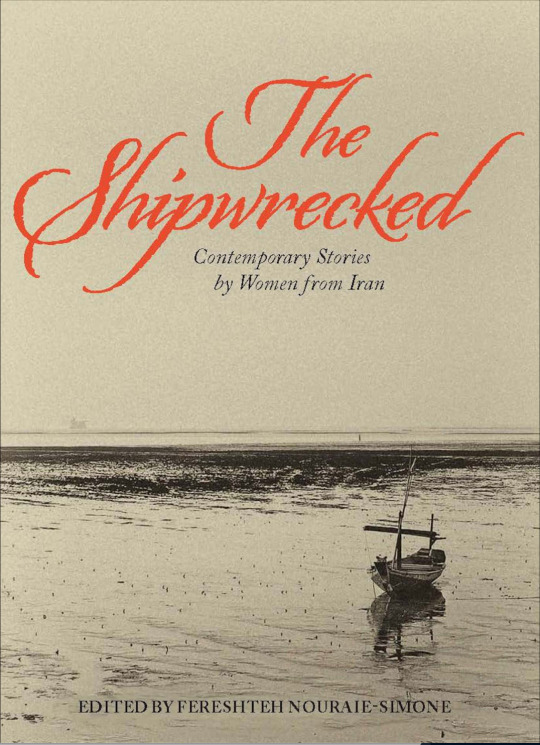
The Shipwrecked: Contemporary Stories by Women from Iran is a collection of short stories by Iranian women writers, largely emerging after the 1979 revolution. These stories delve into gender and sociopolitical issues, revealing how politics infiltrate daily life and personal spaces in contemporary Iran. Revolution, war, and religious segregation shape the lives of women, with political forces influencing both their bodies and their private worlds. Although not outwardly political, the protagonists convey anger and disillusionment, using their voices to resist dominant power structures and challenge gender norms. Their narratives center on survival, subversion, and the pursuit of individual freedom in a repressive political landscape. Confined by homes, jails, and restrictive clothing, they mistrust authority and grapple with the pressures, harassment, and uncertainty of their circumstances. While some passively endure, others actively seek control over their lives, united in their struggle for autonomy and defiance of the limitations imposed upon them.
This past weekend, I chose to read the “Introduction” (vii-xvi) from the collection and the title short story (1-12). While reading, I found myself drawn to the way Moniru Ravanipour’s use of magical realism parallels Khaled Hosseini’s grounded realism in exploring trauma, though her allegorical approach gave me a fresh lens through which to view these struggles. Having read Hosseini’s works, like The Kite Runner and A Thousand Splendid Suns (possibly one of my favorite novels), I was curious to see how Iranian narratives of repression and loss compared to Afghan and South Asian literary traditions.
Ravanipour’s story illuminated how allegory can be a powerful tool for critiquing authoritarianism and giving voice to the silenced. The magical elements in The Shipwrecked allow for a deeper examination of political oppression and the sense of helplessness felt by ordinary citizens. Unlike Hosseini’s more direct portrayal of political upheaval, Ravanipour’s dreamlike approach added layers of nuance, where the boundaries between fantasy and reality blur, intensifying the emotional impact.
I particularly enjoyed how the story unfolded like a fable, with elements of magical realism growing out of the harsh reality of authoritarian repression. This use of allegory reminded me of South Asian literature, particularly works from Pakistan and India, where magical realism also plays a role in expressing trauma and resistance, such as in Mohsin Hamid’s Exit West. Like Hamid's use of doorways as a metaphor for escape and survival, Ravanipour’s sea represents both a space of loss and liberation, where the boundaries between the living and the dead blur, allowing the silenced to find their voice.
This story challenged my preconceptions about Iranian literature. I had expected the political themes, but I was surprised by the subtle, almost poetic way Ravanipour wove the political and the personal. The Shipwrecked offers a more mystical approach to political resistance. In South Asia, while magic and allegory are often used to address historical traumas, as seen in Hamid’s works, there’s often a direct confrontation with the cultural and religious forces at play. Ravanipour’s story, with its focus on the internalization of loss and survival, reflects a subtler but equally powerful form of resistance. The shared cultural threads of post-colonialism and the impact of political instability run through both Iranian and South Asian narratives, but the ways in which characters cope with and resist these forces differ, creating a distinct literary experience.
Overall, I thoroughly enjoyed reading a non-academic piece of writing (for a change). In this collection, I discovered unique expressions of female agency in the face of repression, realizing how literature from Iran, much like South Asian narratives, challenges global stereotypes about women’s lack of power. Ravanipour’s stories present a potent form of resistance through subtle yet powerful acts of survival and defiance. It also makes me wonder how I can utilize fictional writing better in my own dissertation research.

Fereshteh Nouraie-Simone. 2014. The Shipwrecked : Contemporary Stories by Women From Iran. New York, NY: The Feminist Press at CUNY. https://search-ebscohost-com.proxy.library.upenn.edu/login.aspx?direct=true&db=e700xna&AN=954497&site=ehost-live
~Fiza
9 notes
·
View notes
Note
I love the way you write, you're so articulate, I wish I could write like that 😭 I'm guessing you get good grades in school? Do you have advice on how to write articulately and clearly while also sounding professional? Like in essay writing?
Huuuu, that’s very kind of you 🥹;-; I’d never imagine anyone saying that to me… ever.
Well, my grades are good, I have my last exams soon ^^
I do have a few tips! Or rather, there are things I’m still currently learning that may be helpful to you as well📝:
(Sentence) Structure: I read a book called ‘elements of style’ by William Strunk (revised edition) recently and I learned that no matter how grammatically correct your sentences are, there are still ways to improve its structure. (I had to learn it all over again in English -.-) This is a big topic so I'll name a few specifics you can dive into.
Learn the difference between active and passive voice (passive isn’t bad and sometimes necessary, but active is almost always preferred). Don’t mind all this on your first draft though. It’ll only hinder you.
Study MRU (motivation-reaction units), often used in Fiction writing, but it helped me for essays as well. It is the logical pattern of cause and effect introduced by Dwight V. Swain and I read about it in 'techniques of the selling writer'. Here's an article on the topic as well.
Mind paragraphs. There are different rules for this depending on what you’re writing, but it helps its readability. For Essays especially it’s always good to keep topics separate and lead the reader to your conclusion in a way that makes sense. (It's sorta like holding their hand and going like "because of this... there is this... and therefore... and so.... that's why....") This may need some reorganizing of your premises/subjects at times. I especially need to organize my thoughts before I even start writing.
Understand what it is that you need to write about and delete everything that isn’t relevant. If you’re like me and you get a ton of new ideas once you delve into a subject, then it’s good to keep a folder (or something similar) for these new ideas. Often these are entire topics on its own and including these into another will only make both unclear and your conclusion muddy. So, ask yourself whether it strengthens your point, or if it’ll make it more confusing. If it won’t make a difference then delete it anyway or save it in your folder for later.
I always learned that objectivity is important in order to sound professional, though it depends on the kind of essay you’re writing. If you need to convince the reader of something then transparency about your own opinions can help your conclusion be more honest, but be careful of sounding preachy as well. I had to learn all these things when I still studied marketing/communication in entertainment, but it often makes me feel slimy because it’s all very manipulative. (Hence, I quit that path.) It's in fiction as well. Some authors let their own views bleed through their characters in such a way it becomes uncomfortable because it doesn’t argue for the story nor adds to the character— it attacks the reader’s personal morals which possibly gives them an ass-spanking while they’re at it which just really isn’t necessary. Emotional language is fine I think. Sometimes I got compliments from teachers especially because I didn't sound too professional, it requires a bit of knowledge when you can get away with it probably. Just make sure you can back up your arguments/statements and possibly add different views as well. In a way it's more about the confidence in which you present an idea than sounding professional and not being able to understand all the 'why's' I believe.
This one isn't that relevant for school-essays, but sometimes when writing one the question isn't clear. It helps both you and the reader to reformulate it in the beginning. Essays as well as stories are often nothing more than a problem you need to give an answer to. Even if there's no question, it helps to make one anyway so you don't wander off endlessly and drown in a sea of possible subjects you could write about.
Something that may help you as well— I created a roadmap for myself and the different types of things I have to write. That way I always know what to do first and it helps me structure both the essay and my process as I can get easily distracted otherwise. Making more decisions than necessary makes me freeze up, but with a roadmap I don’t have to do either.
Uuh, I've probably picked up on tons of helpful things lately, but I think these are great to start with. I hope they are helpful to you.
I always wanted to (story-)write, but gave up on it and decided to learn how to draw instead. Then, I sort of realized that I was being an idiot, because that desire never left and I had to write other things anyway— like this for example, and simply accepting the fact that no one can understand the load of incomprehensible rubbish I wrote, just wouldn’t do. You can check my older posts… it’s awful. If I ever intentionally want to give myself another headache, I’ll go and read those.
It’s definitely not perfect now, but hopefully I improved though. I think so. Sometimes I still get scolded as I tend to ping-pong between thoughts suddenly and I can hardly tell the difference between BrE/AmE. (As I grew up I learned English mostly through a sort-of-aunt figure from Canada that always forced me to watch British tv with her.) But, the past few months I especially had to write many essays and (argumentative) case studies so I decided to learn and become better in writing. If that translated back to Tumblr then I'm happy and you’ve made my day ><
22 notes
·
View notes
Text
Kisho-Shabalic Script and a bit of the Kishic Language: Basics
As with the Kishic spoken languge, the Kishic script descendeds from and is largely identical to the Shabalic script, thus the term Kisho-Shabalic. Kisho-Syllabic is one of three scripts used in Kishetal along with Kishic hieroglyphs (reserved for religious/cultic purposes) and the logographic Shetalic script, which has fallen almost entirely out of favor.
NOTE!!!! THIS IS AN OLD POST AND IS NOW OUTDATED! SEE THE UPDATED POST HERE!
((Sorry this is so late and such a huge post)

The Kisho-Shabalic script is syllabic, thus each symbol is representative of one syllable composed of a consonant and a vowel. In addition there are characters used to symbalize the conclusion of a thought, in similar fashion to the Latin "." and "?", and the presence of a proper noun or divine status.
Vowels
As a general rule when transcribing the Kishic script, when two of the same vowel are put next to one another, they are treated as a single vowel, rather than elongated as we might see in English with words like book or meet. Two different vowels, as if O and E, E and A, and so on, are almost never put directly beside each other. In the rare instances when this does occur the "stronger" of the two vowels will cover the other. The order of greatness from least to greatest is as follows:
i-e-a-o-u
e.g. the substantive "the talk" Akki- (verb) + -ul (substantive ending) Akkiul Akkiul Akkul
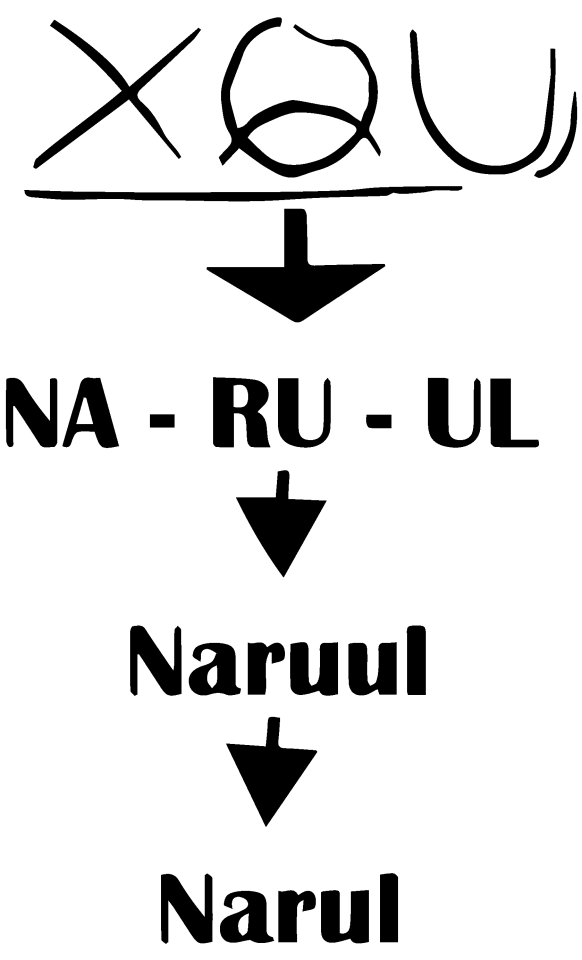
Special Note: One important differentation between the Shabalic language and the Kishic language is that the Kishic language allows for the placing of multiple consonants in sequence. Take for example the Kishic name Ninma, in its original Shabalic form it would be Ninama. Because of the fact that Kishic does have this trait, it has developed its own unique form of punctuation, a vowel drop. When placed below one of the syllabograms shown above, it cancels out the vowel, in essence rendering it mute. Ninma could alternatively be spelled using the formulation NI-IN-MA, similiar to how Narul was spelled above, this is largely a matter of personal preference. The more traditional (Shabalic) form is often times considered more in keeping with nobility.
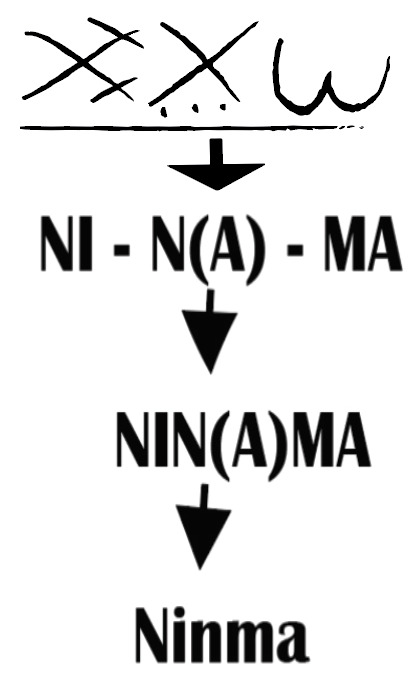
Sentence Structure
The Kishic language primarily follows a subject-object-verb structure.
Nar(u)l Nina(a)ma hara(a)ziga(a)s. Narul Ninma harazigas. Narul Ninma carried. Narul carried Ninma.
Noun and Adjective Declensions
The Kishic language system consists of the following cases: nominative, genitive, dative/accusative, and possessive (the Shabalic language includes an instrumental case), and distinguishes between two numbers (singular and plural) and two genders, Masc (masc/neutral/inanimate) and Feminine.
A few examples of the scheme of suffixation are given in the tables below.
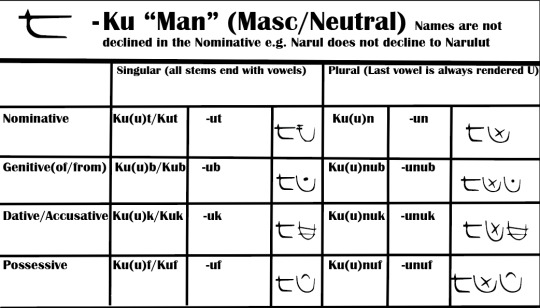
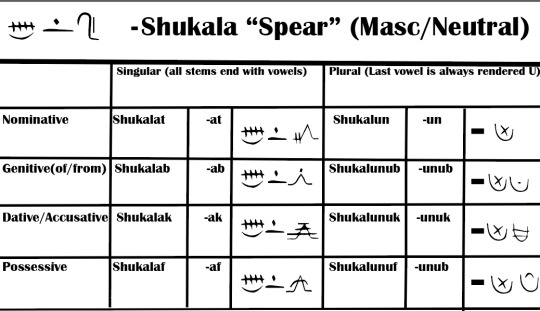

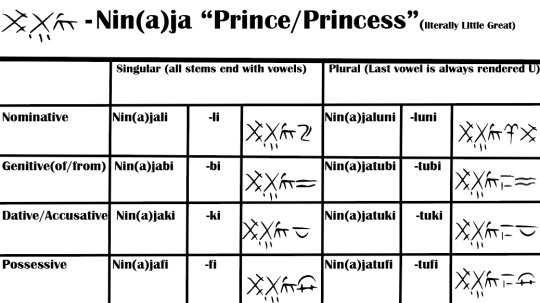
Sample Verb Stems
Verb stems always end with -i.
Talk: Akki
Breathe: Ki
Eat: Ushki
Struggle: Nari
Sleep: Eshsi
Fight: Orishri
Hunt: Pabakazi (Literally Bow art(ing))
Dance: Irteti
Kiss: Mishuzi
Copulate (and the more vulgar equivalent): Seshiti/Tu(u)ki
Verbal Conjugation
There are two general verbal classes according to which verbs are inflected, the aha-conjugation and the awa-conjugation. Within the Kishic language there are two voices (active and medio-passive), three moods (indicative, subjunctive, and imperative), two aspects (perfective and imperfective), and nine tenses (Simple Past, Perfect Past, Continuous Past, Simple Present, Perfect Present, Continuous Present, Simple Future, Perfect Future, Continuous Future).
The present tense can be identified by -i/-a/-u, past by -as, and future by -ad.
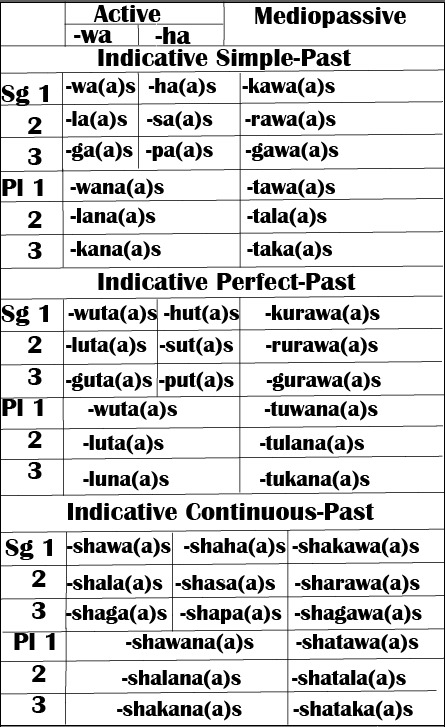
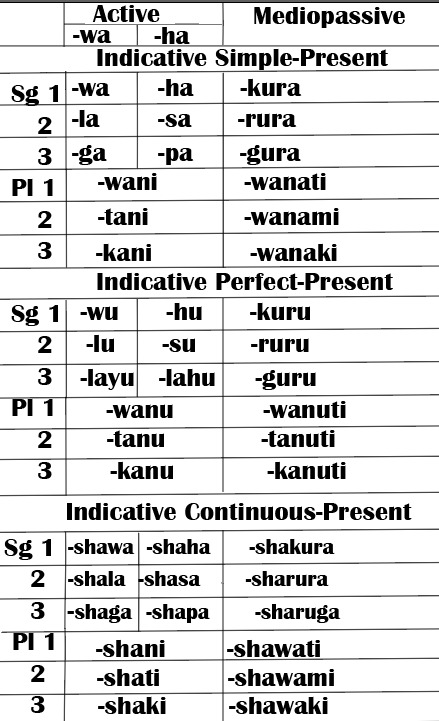

Additionally, the verbal system displays infinitives and participles in the present and past tenses.
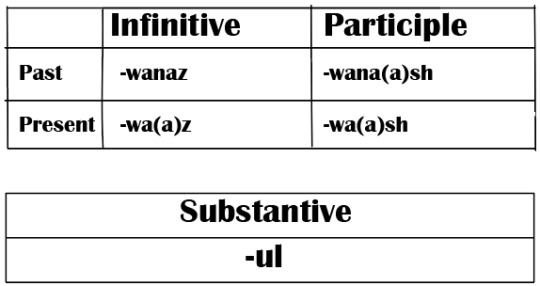
Prounouns


Articles

Sample Sentence
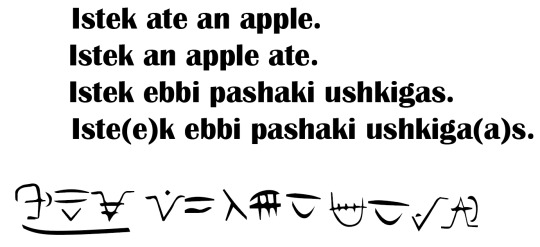
#writeblr#worldbuilding#fantasy#writing#wip#queer fantasy#fantasy world#conscript#fantasy language#fantasy writing#world building#testamentsofthegreensea#conlang#kobaniquestions
22 notes
·
View notes
Text
The Revolution Will Be Harmonized: A New Frequency of Change

When Gil Scott-Heron declared that The Revolution Will Not Be Televised, he was telling us that real transformation happens beyond the spectacle—beyond what mainstream media can capture. It’s internal, spiritual, and lived, not performed for an audience. But in this new era of awakening, we must take that understanding further.
The revolution will not just be fought.
It will not just be televised or broadcast.
It will be harmonized.
The Frequency of Change
What does it mean to harmonize a revolution? To harmonize is to bring different elements together in balance, to create unity from diverse sounds, to take chaos and make it resonate. In music, harmony is more than just notes—it’s vibration, energy, and alignment. And isn’t revolution, at its core, a shift in vibration?
The great upheavals of history—civil rights movements, spiritual awakenings, artistic renaissances—were not just about laws and policies. They were about changing the energy of a people, breaking old frequencies and tuning into something higher. Whether it was Coltrane’s A Love Supreme or Bob Marley’s "Redemption Song," true revolutions have always had soundtracks. Music has always been a portal.
And now, in an age where so much feels out of tune—where discord rules the airwaves and low frequencies dominate the culture—we are being called to harmonize.
Tuning Into a Higher Reality
Music is not just entertainment. It is an ancient technology, a spiritual tool, a divine language. Every note carries a vibration, and every vibration shifts reality in unseen ways. Our ancestors knew this. Drums weren’t just instruments; they were the heartbeat of a people. Chants weren’t just words; they were spells, prayers, and invocations.
To harmonize the revolution means to tap into this power again—to use music, vibration, and frequency as the tools of transformation. It means rejecting noise and dissonance, tuning ourselves to a higher key, and aligning with something greater than ourselves.
This is why certain artists, certain songs, and certain frequencies feel different. Why listening to Aretha Franklin can feel like a spiritual experience. Why the right music at the right moment can feel like divine intervention. Why some voices, like Prince’s or Michael Jackson’s, carry a purity that transcends time.
Because sound is sacred. And so is revolution.
Beyond Resistance: A Revolution of Resonance
For too long, revolution has been framed as a battle—one force against another, one side trying to overpower the other. But what if true revolution isn’t about fighting, but about resonating? About shifting the collective energy so profoundly that the old structures simply cannot stand?
This is not passive. It is not weak. It is a radical act to raise one’s frequency in a world that thrives on low vibrations. To reject fear, manipulation, and discord and instead embody love, balance, and truth is the highest form of resistance.
To harmonize the revolution means to move with intention. To create, rather than just destroy. To build, rather than just tear down. To align with a frequency so strong, so undeniable, that it transforms everything it touches.
This is what the great artists and visionaries have always done. It’s what John Coltrane did when he played like he was speaking to the heavens. It’s what Marvin Gaye did when he asked What’s Going On? It’s what Prince did when he whispered about a "Power Fantastic."
It’s what we are being called to do now.
A Call to Tune In
The revolution will not be chaotic noise.
It will not be empty rebellion.
It will be harmony.
Each of us is an instrument in this symphony. We are being called to tune ourselves—to cleanse our frequencies, to align with truth, to use our voices, our sounds, our vibrations to create something new.
This is not about passive peace. It is about active harmony. About stepping into our power, knowing that real transformation happens not when we scream into the void, but when we resonate so deeply that the void has no choice but to shift.
The revolution will be harmonized.
Are you ready to tune in?
#music#artists on tumblr#black tumblr#artwork#spirituality#music frequency#higher frequency#frequencies#raise your vibration#revolution#john coltrane#gil scott heron#marvin gaye#prince#michael jackson#aretha franklin#bob marley
1 note
·
View note
Text
Some Tips & Advice for Writing Fiction
"Since advice is usually ignored and rules are routinely broken, I refer to these little pearls as merely 'suggestions.'....There’s nothing binding here. All suggestions can be ignored when necessary." —John Grisham
Love your story. Many writers create their best work when they’re deeply invested in their characters and plot.
Withhold information from your readers. When writing fiction, only give readers the information they need to know in the moment. Ernest Hemingway’s iceberg theory in writing is to show your readers just the tip of the iceberg. The supporting details—like backstory—should remain unseen, just like the mass of an iceberg under the water’s surface. This prevents readers from getting overwhelmed with information and lets them use their imagination to fill in the blanks.
Write simple sentences. Think of Shakespeare’s line, “To be or not to be?” famous for its brevity and the way it quickly describes a character’s toiling over their own life. There is a time and place for bigger words and denser text, but you can get story points across in simple sentences and language. Try using succinct language when writing, so that every word and sentence has a clear purpose.
Mix up your writing. To become a better writer, try different types of writing. If you’re a novelist, take a stab at a short story. If you’re writing fiction, try writing nonfiction. Try a more casual writing style by blogging. Each piece of writing has a different point of view and different style rules that will help your overall writing skills.
Write every day. Great writers have a regular writing habit. That means dedicating time every day to the craft of writing. Some writers assign themselves a daily word count; Stephen King writes 2,000 words a day. You might also join a writing group; being accountable to other people is a great motivator. Don’t worry if what you jot down is technically bad writing or you struggle to get something onto a blank page. Some days will be more productive than others. The more you write the easier it gets.
Set milestones. The average word count for a book is 75,000 words. That can make novel writing intimidating. If you’re working on your first novel, stay motivated by setting milestones. This will help you break the book down mentally so it is easier to manage and easier to stick with.
Understand basic story structure. Professional writers are well-versed in the framework most stories follow, from exposition and rising action through to the climax and falling action. Create an outline to map your main plot and subplots on paper before you get started.
Don't write the first scene until you know the last. This necessitates the use of a dreaded device commonly called an outline. Virtually all writers hate that word. Plotting takes careful planning. Writers waste years pursuing stories that eventually don’t work.
Learn strong character development techniques. There are effective ways to create a character arc in literature. Learn what character information to reveal to increase tension in your story. Your main characters should have a backstory that informs their actions, motivations, and goals. Determine what point of view (POV)—first person or third person—complements the character’s interpretation of events.
Use the active voice. Your goal as an author is to write a page-turner—a book that keeps readers engaged from start to finish. Use the active voice in your stories. Sentences should generally follow the basic structure of noun-verb-object. While passive voice isn’t always a bad thing, limit it in your fiction writing.
Take breaks when you need them. Writer's block gets the best of every writer. Step away from your desk and get some exercise. Getting your blood flowing and being in a different environment can ignite ideas. Continue writing later that day or even the next.
Kill your darlings. An important piece of advice for writers is to know when words, paragraphs, chapters, or even characters, are unnecessary to the story. Being a good writer means having the ability to edit out excess information. If the material you cut is still a great piece of writing, see if you can build a short story around it.
Don't introduce 20 characters in the first chapter. A rookie mistake. Your readers are eager to get started. Don’t bombard them with a barrage of names from four generations of the same family. Five names are enough to get started.
Read other writers. Reading great writing can help you find your own voice and hone your writing skills. Read a variety of genres. It also helps to read the same genre as your novel. If you’re writing a thriller, then read other thrillers that show how to build tension, create plot points, and how to do the big reveal at the climax of the story.
Read beyond what you like. Dutch writer Thomas Heerma van Voss says: "Read as much and as widely as possible. See how other writers construct their scenes, tease the reader, build tension. Don’t be afraid, especially when starting out, to steal or imitate – all arts begins with imitation. One of the Netherlands’ most famous writers began his writing career by copying out stories by Ivan Turgenev in an effort to master his rhythm and way of writing."
Read writers who do not write like you. Trinidadian-British poet Vahni Capildeo says: “Make friends with writers who do not write like you. Swap books. Show each other work. Take the long view and the wide view. Writing adds your lifetime to the lifetime of everyone else who has written or read, or who will read or write, including non-‘literary’ folk. All sorts of people work carefully or lovingly or effectively with words. You may find inspiration in a law report (ancient or contemporary) or a tide chart, or in an ‘unplayable’ play…"
Research. Critically acclaimed novelist Guinevere Glasfurd says: “Writers are often exhorted to ‘write what they know’. But what if your protagonist is a fourteenth-century nun? Or a drag queen from Kentucky (and supposing you, the writer, are not)? Start by reminding yourself why you want to tell the story. Research can be frustrating; sometimes the archive is silent, the answers are not there. There’s a reason for that and that should spark other questions. Research can also be enormously rewarding. It can, and likely will, reveal something unexpected. It is important to remain alert to that, to be attentive and open to surprise. Research is an iterative process. Research a bit, write a bit, research a bit more. Allow your writing to remain fluid at this point, open to question, encouraging of further enquiry.”
Write to sell. To make a living doing what they love, fiction writers need to think like editors and publishers. In other words, approach your story with a marketing sensibility as well as a creative one to sell your book.
Write now, edit later. Young writers and aspiring writers might be tempted to spend a lot of time editing and rewriting as they type. Resist that temptation. Practice freewriting—a creative writing technique that encourages writers to let their ideas flow uninterrupted. Set a specific time to edit.
Get feedback. It can be hard to critique your own writing. When you have finished a piece of writing or a first draft, give it to someone to read. Ask for honest and specific feedback. This is a good way to learn what works and what doesn’t.
Think about publishing. Few authors write just for themselves. Envision where you want your story to be published. If you have a short story, think about submitting it to literary magazines. If you have a novel, you can send it to literary agents and publishing houses. You might also consider self-publishing if you really want to see your book in print.
Ignore writing advice that doesn't resonate with you. Not every writer works the same. You have to figure out what works for you in the long run. If working off of bullet-point outlines gives you hives, then don't do it. If you work best writing scenes out of order, then write those scenes out of order.
Sources: 1 2 3 4 ⚜ More: Writing Notes & References
#writing tips#writing advice#writeblr#studyblr#booklr#fiction#writers on tumblr#spilled ink#dark academia#light academia#literature#creative writing#writing prompt#on writing#writing reference#writing resources#poets on tumblr
145 notes
·
View notes
Text
10 Ways to Make Storytime Magical with WHAT IF?
There’s something timeless and beautiful about reading to a child. Perhaps it is the bonding, imagination, and joy of wonder of reading together. Ciara Newell-Bailey’s whimsical picture book WHAT IF?, in light of this, is the perfect companion to transform your daily storytime into a moment of magic. With questions like “What if fruit could see?” or “What if bicycles had wings?”, the book invites interaction, laughter, and creative exploration.
Here are 10 ways to make storytime with WHAT IF? truly unforgettable:
Use Different Voices for Every Question: Give each line its own personality. Ask the questions in silly, dramatic, or mysterious voices. Kids will love guessing what comes next and will soon be chiming in with their own impressions.
Act It Out: Turn the questions into mini-performances. Pretend to fly on a bicycle or whisper secrets to a teddy. Kids love movement—it makes the words come alive.
Add Props or Toys: Bring in stuffed animals, toy vegetables, or a tiny plastic bathtub to represent scenes from the book. These simple objects turn passive listening into an active play experience.
Let the Child Answer the Questions: Pause after each “What if?” and ask your child, “What do you think?” Their answers will surprise and delight you and deepen their engagement with the story.
Create a “What If?” Craft Jar: Write your own silly “What if” questions on slips of paper and pull one out before bedtime. Let your child draw the answer or act it out. It’s a great way to extend the book beyond the pages.

Draw the Scenes Together: After reading, grab some crayons and paper. Ask your child to draw what they think a tree that can jump looks like, or what kind of cake a cat might bake. Creativity flows easily after storytime!
Make a Bedtime Ritual: Use WHAT IF? as a calming evening routine. The rhythmic structure and gentle humour are perfect for winding down. You can even create your own nighttime “what if” questions to close the day with a smile.
Let Kids “Read” to You: Children can remember repeated lines even if they can’t read yet. So, encourage them to “read” the book back to you using memory and pictures. It boosts confidence and makes them feel like storytellers too.
Personalise the Questions: Change the names or settings to fit your child’s world: “What if YOUR teddy had listening ears?” or “What if we flew over our house on a winged bicycle?” This personalisation increases connection and excitement.
Record a Storytime Video Together: Let your child take the lead in reading or acting out a scene. Record it and watch it together. It builds pride in their creativity and helps them connect deeply with the book.
WHAT IF? is a launchpad for wonder. Every question is an open door to imagination, laughter, and learning. By turning storytime into an interactive experience, you create magical memories and build language, emotional awareness, and creativity.
So tonight, don’t just read WHAT IF?. Live, feel, and play with it because the more you interact with this story, the more you will learn and grow.
Order your copy on Amazon: https://www.amazon.com/dp/B0FD4915G2.
0 notes
Text
Common Grammar Mistakes Caught by Proofreading Experts
Even the most experienced writers make grammar mistakes. Whether it's a rushed email, a complex academic paper, or a blog post written in flow, certain language errors tend to slip through unnoticed. That’s why Proofreading and Editing Services are essential—not just for catching typos but for identifying subtle grammar issues that weaken the clarity and credibility of your writing.
Professional proofreaders are trained to spot these errors quickly and correct them while preserving the writer’s tone and message. If you're publishing, submitting, or pitching content, getting a second pair of expert eyes can make all the difference. Explore our Proofreading and Editing Services to ensure your work is grammatically flawless and professionally polished.
1. Subject-Verb Agreement Errors
One of the most common grammar issues is incorrect subject-verb agreement. This happens when a singular subject is paired with a plural verb or vice versa.
Incorrect: The list of items are on the table. Correct: The list of items is on the table.
Proofreaders carefully scan for these inconsistencies, especially in complex sentences where the true subject isn’t always obvious.
2. Misplaced or Dangling Modifiers
Modifiers are words or phrases that describe something else in the sentence. When placed incorrectly, they create confusion—or unintended humour.
Incorrect: Running through the forest, the trees looked beautiful. Correct: Running through the forest, she thought the trees looked beautiful.
Proofreading experts restructure such sentences to ensure modifiers clearly refer to the intended subject.
3. Confusing Homophones
Words that sound alike but have different meanings and spellings—like their, there, and they’re—are easy to mix up, especially during fast writing.
Examples:
Your vs You’re
Its vs It’s
Affect vs Effect
Spell check won’t catch these because they’re not technically misspelled. But proofreaders do.
4. Improper Tense Usage
Tense mistakes—shifting between past, present, and future inconsistently—can confuse readers and disrupt flow.
Incorrect: She walks into the room and picked up the phone. Correct: She walked into the room and picked up the phone.
Editors ensure that your verb tenses are consistent and aligned with the timeline of the narrative.
5. Overuse of Passive Voice
While passive voice isn’t grammatically wrong, it often makes sentences less direct and harder to follow.
Passive: The report was written by the intern. Active: The intern wrote the report.
Proofreaders rephrase overly passive writing to sound clearer and more engaging, especially in business and academic content.
6. Missing or Misused Commas
Comma errors are surprisingly common. Writers may leave them out entirely or sprinkle them where they don’t belong.
Examples:
Missing comma after an introductory phrase: After the meeting we went for lunch. → After the meeting, we went for lunch.
Misplaced commas in restrictive clauses: Students who cheat should be punished. (correct) Students, who cheat, should be punished. (implies all students cheat)
Proofreaders catch these nuances that automated tools often miss.
7. Run-on Sentences and Sentence Fragments
Run-on sentences cram multiple ideas without proper punctuation, while fragments lack a complete thought.
Run-on: She loves painting she also teaches art. Corrected: She loves painting, and she also teaches art.
Fragment: Even though she was tired. Corrected: Even though she was tired, she finished the report.
Proofreading experts ensure sentence structure is logical and complete.
8. Redundant or Repetitive Words
Redundancy makes writing feel clunky and unrefined.
Examples:
Each and every → Choose one
Past history → History implies past
Absolutely essential → Essential is already absolute
Professional editors trim such repetition to make your writing more concise and powerful.
9. Incorrect Use of Articles
Non-native English speakers often struggle with a, an, and the—especially when referring to general vs specific items.
Incorrect: She adopted a orphan. Correct: She adopted an orphan.
Proofreaders ensure article use aligns with grammar rules and context.
10. Inconsistent Capitalization
Writers sometimes capitalize words inconsistently—especially job titles, departments, or headers.
Incorrect: She works in the Human resources Department. Correct: She works in the human resources department.
Proofreaders fix these to maintain a clean, professional tone throughout the text.
Final Thoughts
Grammar mistakes, even small ones, can undermine the impact of your writing. They distract readers, weaken your credibility, and create confusion—especially in academic, professional, or published work. That’s why Proofreading and Editing Services are essential for anyone serious about clear and error-free communication.
Let experts handle the grammar while you focus on your ideas. Get your work reviewed today with our trusted Proofreading and Editing Services for spotless, impactful writing.
0 notes
Text
How I Automated 80% of My Dropshipping Business Using AI Tools
When the rise of e-commerce began accelerating in the early 2020s, it seemed like anyone could launch an online store and start earning passively with minimal effort. But behind the scenes, those running a dropshipping business quickly discovered the reality: countless hours spent on product research, customer support, order tracking, supplier communication, and marketing execution. The model still held its appeal — low overhead, no inventory risk — but the daily grind made scaling difficult without more hands or more time.
By 2025, artificial intelligence has transformed that reality. Automation is no longer just a time-saver; it’s a competitive edge. Over the past year, I systematically replaced or enhanced the most repetitive parts of my dropshipping operations with AI-powered tools. The result? A leaner, more efficient business that runs 80% without my direct involvement — leaving more time to focus on long-term strategy and brand development.
the turning point: why automation became necessary
Like many, I started my dropshipping journey full of energy and optimism. I chose trending niches, tested multiple ad creatives, and even handled customer emails personally in the beginning. But as sales scaled, so did complexity. Product updates, ad management, and refund requests were eating into hours I could have spent finding new opportunities or improving customer experience. That’s when I started identifying patterns in what I was doing manually every day — patterns AI could easily handle.
discovering the time-eaters
Product research turned out to be one of the biggest time drains. Every week I’d dig through marketplaces, filter by trending tags, compare reviews, and manually validate product potential. With AI, this changed dramatically. Tools now scan real-time search trends, analyze what’s selling well in each category, and even predict future winners. I used these insights to add popular products to my store faster than competitors and adjust listings based on seasonality or market shifts.
writing product descriptions no longer took hours
Creating engaging product descriptions was another time-intensive task. With the help of AI copy tools, I generated SEO-optimized titles and persuasive bullet points in seconds. These tools even adapted tone and structure based on my store’s brand voice. Of course, I still reviewed and fine-tuned the content, but 90% of the heavy lifting was done. This freed up hours every week while maintaining consistency across listings.
scaling customer service without extra hires
Customer support is critical in any dropshipping business, especially when shipping times vary or orders get delayed. Instead of outsourcing to a team, I integrated a chatbot powered by natural language processing. It now handles about 70% of customer queries — tracking numbers, return instructions, and FAQs — with only complex issues escalated to my inbox. The bot learns from interactions over time, meaning responses become more accurate and helpful.
social media content generation simplified
Staying active on social platforms is essential for brand awareness, but creating new posts daily is exhausting. AI image and video generators helped me repurpose product videos into short clips with trending captions and viral hooks. I also used scheduling tools that suggested optimal posting times based on audience engagement history, allowing me to batch content creation in advance while maintaining visibility.
ad campaigns became smarter and less risky
Paid ads were once a guessing game, with multiple A/B tests and inconsistent results. With AI ad tools, I now upload a set of creatives, and the system automatically adjusts copy, audience targeting, and budget allocation based on performance in real time. This not only improved my return on ad spend but also significantly reduced wasted ad dollars on underperforming campaigns.
backend efficiency through order and inventory automation
Order management was another area that benefited from automation. With tools integrated into my store, customer orders sync instantly to the supplier, and tracking numbers are updated automatically. Inventory levels are monitored live, and I receive alerts when stock gets low. For products sourced through platforms like Cheersdrop, the system ensures faster fulfillment and better visibility, helping reduce customer complaints due to stock issues.
analytics and decision-making got faster and sharper
AI-powered dashboards now give me daily snapshots of what’s working and what’s not — from sales spikes to abandoned cart rates. Instead of combing through spreadsheets, I get actionable insights within minutes. This has helped me launch new collections of popular products at the right time and pull underperforming items quickly before they hurt my conversion rates.
balancing automation with the human touch
Even with all the automation, there are areas where a personal touch still matters. Brand storytelling, community building, and high-level product curation aren’t easily replicated by machines. I still handle creative direction, supplier relationship management, and long-term marketing strategy personally. Automation allows me to do these high-impact tasks with more focus and clarity.
the results: less burnout, more scalability
Within months of implementing these tools, the change was obvious. I was working fewer hours, making faster decisions, and responding to customer needs more effectively. More importantly, the business became scalable. Rather than being stuck in the cycle of operational work, I could finally test new offers, expand into other categories, and even explore building a secondary store under a different niche.
future outlook: where automation is heading next
Looking ahead, the dropshipping business model is only becoming more technology-driven. AI agents are being developed that can autonomously manage entire storefronts — responding to trends, adjusting pricing, and handling outreach. While it’s unlikely that human oversight will ever disappear completely, the trend is clear: those who embrace automation early are positioning themselves ahead of the curve.
final thoughts
In a space where timing, relevance, and customer experience are everything, automation doesn’t replace strategy — it enables it. With the rise of e-commerce showing no signs of slowing down, competition is only growing. But so is the opportunity. By using AI to handle the repetitive and predictable, you free up time and mental bandwidth to focus on growth, branding, and connection. That’s where the real value lies. The tools are here, and for those willing to learn and adapt, they can redefine what it means to run a dropshipping business in 2025 and beyond.
0 notes
Text
AlphaTale Gaster bitty
Name: Hollow
Species: Skeletal Otter
Rank: Beta
Size: 7-9 inches tall(Mini), 1'6-2'6 feet tall(Fullsized), 5'6-6'6 feet tall(Bara)
Personality: Quiet, introspective, gentle, enigmatic, emotionally attuned, passive, thoughtful, grounded
Likes: Flowing water, soft sand, quiet companionship, candlelight, writing in notebooks, low ambient music, deep conversations, stargazing
Dislikes: Loud arguments, bright artificial lights, forced socialization, sudden changes in tone, emotional dishonesty, high energy chaos, invasive questions
Compatibility: Hollow is an unusual but soothing presence in a home. Rather than actively inserting himself into conversations or routines, he lingers—near enough to be felt, far enough to give others room. His aura is calming, his voice soft and melodic when he chooses to speak. For caretakers or bitties dealing with anxiety, grief, or burnout, Hollow can be a grounding figure—his gentle company often enough to settle nerves.
He is best suited to environments with soft lighting, low noise, and emotionally mature bitties or caretakers. Hollow doesn't do well in places that expect constant interaction; he is slow to open up, but deep once bonded. He is fiercely loyal in his own way, often protecting others silently, keeping a watchful eye from the edges of a room.
That said, households that are loud, heavily structured, or center around dominant personalities may cause Hollow to emotionally retreat. He is especially sensitive to emotional shifts and may become withdrawn or even vanish into his den for extended periods if overwhelmed. Respect for his space and silence is essential.
Feeding habits: Hollow enjoys soft, cold nectars or light fruit teas—especially those with floral or herbal notes. He prefers food that doesn't stain his gloves and will often eat slowly, with ritualistic movements. He may go long periods without eating if emotionally distressed.
Additional info: Hollow is modeled after the African clawless otter, a species known for its tactile sensitivity and calm, deliberate movements. Unlike other skeletal types, Hollow’s bones have a smoother, water-worn look—more rounded at the edges, giving him an almost driftwood-like appearance. His hands are glove-like, with fine grooves carved into the bone where claws would typically be, echoing the species’ naturally clawless nature. These hands are incredibly expressive and are often used to communicate when Hollow chooses not to speak.
Zone: Inside
In Universe: Bitty owners often say Hollow feels “half-spirit,” a quiet guardian who exists between presence and absence. He's said to have a near-telepathic understanding of emotions, and some caretakers claim that he has soothed crying bitties just by being in the room. He’s the one others turn to late at night, when silence stretches long and someone needs to feel understood.
Difficulty: Intermediate – Advanced
#adoptable#bitty bio#bitty info#bittybones#advanced#alphatale#intermediate#alphatale bitty#alphatale info#beta bitty
0 notes